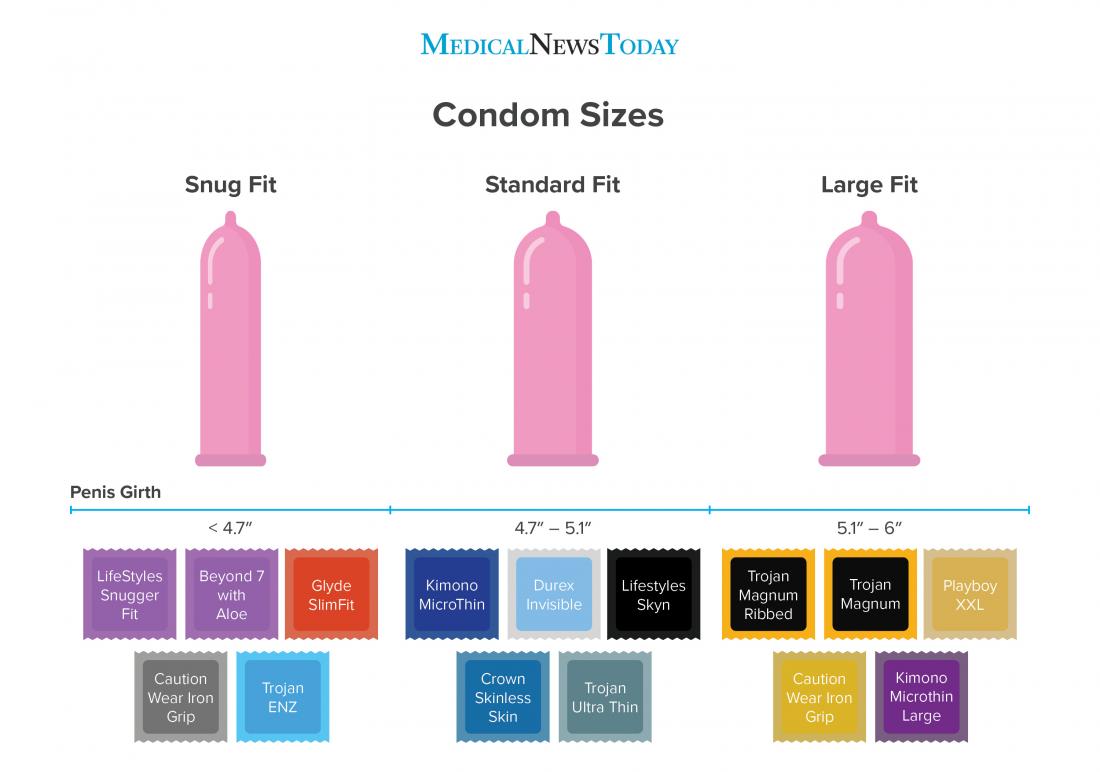How to find the right condom size
Condom size is essential for ensuring the condom is effective in preventing sexually transmitted infections (STIs) and pregnancy.
Condoms that are too small may break, and condoms that are too big can slip off the penis. Poor-fitting condoms can also feel uncomfortable during sex.
In this article, we look at how to choose the right condom based on penis length and girth, how to measure the penis, and other factors to consider when using condoms.

Image credit: Stephen Kelly, 2018
Common condom brand sizing in the United States
There are many condoms to choose from, and most people should not have trouble finding a condom that fits. Manufacturers base condom sizes on both length and width measurements.
Most condoms are longer than they need to be. If a person finds that there is too much roll at the base, they may need a snugger fit. If there is no roll left, they will require a larger condom.
Girth is more important than length for condom fit, with girth being the thickest part of the erect penis.
There is no absolute rule for who should use the different condom sizes, but the following guidelines, which are in inches, may help:
- a girth of less than 4.7″ needs a snug fit
- a girth of 4.7–5.1″ needs a regular fit
- a girth of 5.1–6″ needs a large fit
Condom companies do not always make their sizes readily available, and brand measurements vary between sources.
The following charts will give some information about the size and features of common U.S. condom brands in inches (“) and millimeters (mm), along with links to where you can buy them:
Snug fit
| Brand | Features | Size: Length and width |
| LifeStyles Snugger Fit | Lubricated, special shape, reservoir tip, short and narrow fit | Length: 7″ / 178 mm Width: 1.92″ / 49 mm |
| Beyond 7 with Aloe | Latex, water-based lubricant with aloe to prevent irritation | Length: 7.28″ / 185 mm Width: 2″ / 50.80 mm |
| Glyde SlimFit | Latex, nontoxic, lubricated, tight and snug fit, certified ethical and vegan | Length: 6.70″ / 170 mm Width: 1.93″ / 49 mm |
| Caution Wear Iron Grip Snugger Fit | Snug fit, smaller width, silicone-based lubricant, reservoir tip | Length: 7″ / 178 mm Width: 1.92″ / 49 mm |
| Trojan ENZ | Latex, lubricated, straight-shape, tighter fit, reservoir tip | Length: 7.50″ / 190 mm Width: 2″ / 50.80 mm |
Standard fit
| Brand | Features | Size: Length and width |
| Kimono MicroThin | Latex, ultrathin, unscented, straight-sided shape makes it easier to put on | Length: 7.48″ / 190 mm Width: 2.05″ / 52 mm |
| Durex Invisible | Latex, lubricated, straight shape, ultrathin | Length: 7.50″ / 191 mm Width: 2.04″ / 52 mm |
| Lifestyles Skyn | Made of polyisoprene, unscented, thin, lubricated | Length: 7.50″ / 190 mm Width: 2.09″ / 53 mm |
| Crown Skinless Skin | Latex, lightly lubricated, ultrathin | Length 7.50″ / 190 mm Width: 2.05″ / 52 mm |
| Trojan Ultra Thin | Latex, lubricated, reservoir tip, thin | Length: 7.50″ / 190 mm Width: 2.09″ / 53 mm |
Large fit
| Brand | Features | Size: Length and width |
| Trojan Magnum Ribbed | Latex, spiral ribbing for heightened stimulation, lubricated, reservoir tip | Length: 8.07″ / 205 mm Width: 2.13″ / 54 mm |
| Trojan Magnum | Latex, tapered at the base, lubricated, reservoir tip | Length: 8.07″ / 205 mm Width: 2.13″ / 54 mm |
| Playboy XXL | Latex, lubricated, extra headroom, reservoir tip | Length: 7.48″ / 190 mm Width: 2.20″ / 56 mm |
| Lifestyles KYNG | Latex, lubricated, extra large | Length: 7.48″ / 190 mm Width: 2.20″ / 56 mm |
| ONE Legend | Made of Sensatex (a form of latex), extra wide | Length: 7.87″ / 200 mm Width: 2.30″ / 58.50 mm |
| Kimono Microthin Large | Latex, ultrathin, flared shape for extra headroom, regular base | Length: 7.68″ / 195 mm Width: 2.05″ / 52 mm |
How to measure and choose the right size
The first step to finding the best condom size is to measure the penis. To do this, a person can use a ruler, measuring tape, or piece of string. For the most accurate results, they should take the measurements while the penis is erect.
Use the following steps to take an accurate measurement of the penis and find the best condom fit:
- Measure the length from the base of the penis, where the penis meets the pelvis, to the end of the tip.
- Use a piece of string or a flexible measuring tape. Wrap it around the thickest part of the penis, which is usually near the middle of the shaft. If using string, mark where the string crosses and measure the distance with a ruler.
Does the material matter?
Not only do condoms come in various shapes and sizes, they also contain different materials, including latex, polyurethane, and lambskin.
While manufacturers use latex to make the vast majority of condoms, some brands offer nonlatex alternatives for people who do not like latex or have allergies.
Latex

Latex is the most common material for condoms.
Latex condoms are very flexible, thin sheaths. Latex is an effective barrier against sperm, bacteria, and viruses. However, latex does not transfer heat, which can reduce pleasurable sensations.
A person should avoid using oil or oil-based lubricants with a latex condom.
Oils will break down latex, which may cause the condom to tear. Water- or silicone-based lubricants are the best options when using a latex condom.
Polyurethane
Polyurethane is a plastic material used in many contexts, from insulation to furniture and condoms. Polyurethane condoms are usually thinner than latex condoms, and they are better at transferring heat.
Polyurethane condoms provide effective barriers against HIV and bacterial STIs. However, polyurethane is less flexible than latex, which makes them slightly more fragile than latex condoms.
Polyisoprene
Polyisoprene is very similar to latex, but it lacks the proteins that can sometimes cause allergic reactions. These condoms are slightly thicker than polyurethane, but they are softer and feel more natural than latex.
Lambskin
Lambskin condoms do not contain lamb’s skin. Instead, lamb cecum, a part of the intestine, is the main constituent. The cecum is thin, durable, and good at transferring heat. Unfortunately, lambskin condoms may not protect against STIs or HIV.
How to use a condom properly

A person should be careful not to damage the condom when opening the packet.
Condoms are most effective when used correctly. Use the following advice on how to use a condom properly:
- Check the expiration date on the package. A condom past its expiry date is less effective and more likely to break.
- Make sure the condom is still intact. Condoms that people may store in wallets or purses can be damaged. Make sure the wrapper is intact. If the condom itself is torn or shows signs of damage, do not use it, and discard it immediately.
- Carefully open the wrapper. Avoid using teeth or ripping the package forcefully, as this can tear the condom.
- Make sure the rim is facing the outside so that it is possible to roll the condom over the penis.
- Pinch the tip of the condom and place it on the head of the erect penis. Pinching the tip removes excess air and allows extra space at the top to collect semen.
- Roll the condom down the shaft to the base of the penis.
- If the condom does not have lubrication, apply a small amount of water- or silicon-based lubricant to the outside of the condom.
- After ejaculation, hold the base of the condom while pulling out. Doing this will prevent it from falling off.
- Carefully remove the condom, tie a knot at the open end, and throw it in the trash.
Summary
Choosing the right condom can be a difficult and even daunting task. Once people know the correct size for them, they can do a little research and find their preferred material and style.
Condoms are an essential part of good sexual health. They protect against the spread of both STIs and viral infections, such as Ebola and Zika. They can also prevent unplanned pregnancies.
Finding a condom that fits properly will help prevent pregnancy and protect against STIs. In addition, properly fitting condoms can also enhance the experience of sexual intercourse, making sex more comfortable and enjoyable.





Comments are closed.